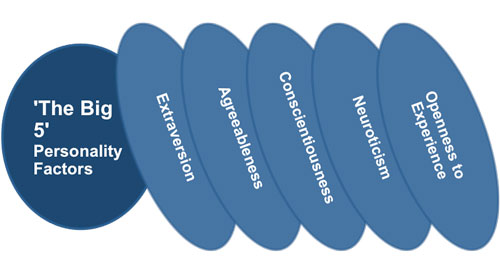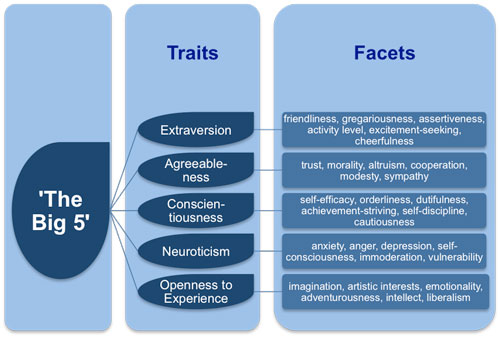The 'Big 5' Aspects of Personality
The five factors Costa and McCrae identified as making up an individual's personality are the traits extraversion, agreeableness, conscientiousness, neuroticism, and openness to experience. (The latter could not be assessed using the 16 PF test or PEN model.)
 |
Extraversion - is defined by a strong need to engage with the external world and other individuals.
Agreeableness - is defined by an individual's desire to cooperate with others to ensure social harmony. (There are instances when the need to get along with people is detrimental to a positive outcome, such as soldiers in time of war, or scientists seeking a cure for cancer.)
Conscientiousness or Prudence - is defined as the way in which we control, regulate, and direct our impulses. It is a person's ability to take into account the consequences of a deed before acting on the impulse to act.
Neuroticism - is defined as the predisposition to experience one or more negative feelings such as depression or anger. The level of emotional reaction decreases a person's ability to make decisions, cope in stressful situations, and think clearly.
Openness to Experience or Culture - is defined as an individual's ability to be imaginative and creative in how they act and think when in different situations. They are often described as nonconformists and have the ability to think in abstracts or symbols that do not directly relate to their own experience. (Some occupations, such as service occupations, sales, and police work are better performed by people whose thinking is more closed.)
An important aspect of 'The Big 5' is that each of the five traits is measured along a continuum showing the extent to which an individual displays it. Each trait is designed to measure the level of intensity and frequency with which an individual displays their feelings, thoughts, and behaviors when interacting in different circumstances. It is also important to note that traits are neutral and carry no positive or negative associations.
 |
Costa and McCrae then expanded each of the five traits into six sub-traits or facets. The significance of these facets is that they can be assessed independently of their trait and give a broader picture of the personality being studied. The facets relating to each of the Big 5 traits are shown in the diagram. People's scores for each facet of a personality trait tend to cluster in similar areas on the continuum, but this is not always the case. Further information is available on the Five-Factor Theory and personality traits and their sub-facets.
You may also be interested in:
Management Personality Tests | The 'Big 5' Aspects of Personality | Popular Personality Questionnaires | Validity Scales | Defining Your Work Personality | 'Make or Break' Questions.



